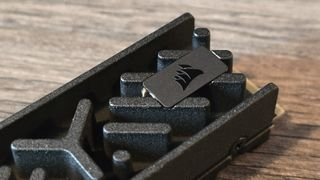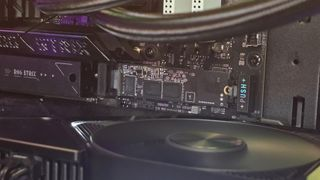Our Verdict
Corsair's PCIe 5.0 MP700 Elite delivers some impressively cool performance. Not only is it remarkably power-efficient, but it also drives some of the best random 4K numbers we've seen to date. Capacities are limited, but if budget is a concern, it's a solid pick for a mid-range build.
For
- Phenomenally cool under load
- Top-tier random 4K performance
- Strong value option
Against
- Slow sequentials relatively
- Cheaper, faster drives available
- Only 1 TB and 2 TB solutions
PC Gamer's got your back
Categorically, what is the biggest problem with PCIe 5.0 drives? It's the heat. At launch, and even now, those early 5.0 units complete with the Phison E26 controller and Micron 232-layer TLC run seriously hot. To the point it was almost impossible to run one without some form of active cooling baked into it. Corsair wasn't immune to this either, despite its street cred as a storage manufacturer first and foremost, and its MP700 line initially featured the reference Phison cooler, complete with in-built fan, and a touch of yellow branding to try and separate it from the crowd.
A lot's changed since then, and we've seen a whole host of non-fan-cooled PCIe 5.0 solutions arrive with us. However, heat has still always been a major concern.
That is what the MP700 Elite looks to rectify in its bold and brave quest to become one of the best SSDs out there today. In short, this is an exceptionally cool PCIe 5.0 drive that not only delivers relatively comfortable performance on the sequential front but does so with both a low power draw and radically lower temperatures as a result. I'm not saying you can run this without a dedicated heatsink just yet, but we're getting close. That does however come with some drawbacks.
As for the hardware, Corsair's built the MP700 Elite around Kioxia's latest 218-layer BiCS8 TLC NAND, combined with Phison's E321T controller. That does mean it comes without any DRAM cache or buffers, but honestly, that's not a huge concern given the raw throughput that Kioxia's NAND can deliver.

Capacity: 2 TB
Interface: PCIe 5.0 x4
Memory controller: Phison E321T
Flash memory: Kioxia 218-Layer BiCS8 TLC NAND
Rated performance: 10,000 MB/s sustained read, 8,500 MB/s sustained write
Endurance: 1,200 TBW
Warranty: Five years
Price: $260 | £235
It's also worth mentioning that this is a single-sided M.2-2280 design, making it pretty ideal for laptops and other consoles, although if you do get the heatsink variant, please do note that it's too large to fit into something like a PS5 Pro (although you can easily disassemble it if you do).
On launch, it's a somewhat limited choice for capacity, sadly. You can grab one of these either as a 1 TB or a 2 TB configuration, and that's it. For this specific 2 TB model I've got on test here, it retails relatively respectable at $260 ($265 with the heatsink), or £235 in the UK (£240 with heatsink). Unfortunately, no AUD availability just yet.
Right, the big thing I need to cover first is temperatures, because boy, is this quite literally a cool drive. At least compared to other PCIe 5.0 offerings. To be clear, almost always, I try to test all of the SSDs I get in for review underneath the exact same heatsink with the same thermal pads. That's done on an Asus ROG Strix X870E-E motherboard. If the drive comes with a heatsink, if possible, I strip it off and chuck it in the board for the full testing suite.

So, for comparison, the Seagate FireCuda 540, a relatively early PCIe 5.0 drive, during its benchmark run, topped out at 83 C. The Crucial T700, which did use its own integrated heatsink, landed at 87°C. The MP700 Elite? 55°C. Ambient room temperature at the time of those tests was 24°C across all three SSDs. That is just a staggering drop in overall heat, and if we're generous and compare it only to the FireCuda 540, there's a 33.7% difference between them.
This is all thanks to Phison's latest E31T controller. In short, it's basically a pseudo-evolution of the E26 found in the bulk of most 5.0 drives to date (Teamgroup's Z540 a good example of that). Although it lacks any DRAM and features half the channels and bandwidth, it's wildly more efficient than the original controllers. That's thanks to Phison moving the manufacturing process from a 12nm FinFET solution to TSMC's 7 nm N7 process instead. It also has half the number of channels, and because of that power draw, equally has been cut significantly as well. What that leads to is a significant drop in overall temps as a result. Certainly compared to drives like Crucial's T700 or Gigabyte's Aorus Gen5 12000.
As for the numbers game, general sequential speeds are about what we saw with the initial PCIe 5.0 launch, albeit with one exception. Crystal Disk manages 10,197 MB/s, respectively, on the read, but 8,608 on the write (the latter quite a bit slower than the FireCuda 540 and Crucial's T700).
Where the MP700 Elite picks its head up, however, is in the random 4Ks. It dominates that field, with 88 MB/s on the read and a whopping 336 MB/s on the write, pipping both of our other PCIe 5.0 drives to the post. As for in-game performance, it basically sat in the middle of the pack, landing a load time of 7.426 seconds in Final Fantasy's Shadowbringers benchmark.
PC Gamer test bench
CPU: AMD Ryzen 9 9900X | RAM: 64 GB (2x32GB) Team Group T-Create Expert DDR5 @ 6000 C34 | GPU: Nvidia GeForce RTX 4080 Super | Motherboard: ASUS ROG Strix X870E-E Gaming WiFi | CPU Cooler: Asus ROG Ryujin III 360 ARGB Extreme | PSU: 1200W NZXT C1200 (2024) 80+ Gold | Chassis: Geometric Future Model 5
The real kicker is the price. There's a lot of tech and hardware featured here that's relatively new to the playing field. Whether that's Phison's E31T controller, which landed with us in September 2024, or Kioxia's latest 218-layer BiCS8 NAND, it all costs money up front to bring this together to the table, and despite this drive being pitched as sort of a "mid-range" entry-level option, it's got some tough competition from older hardware that right now, just kind of works.
✅ Random 4K performance and cooling are everything: The MP700 Elite delivers impressively potent random 4K performance, along with some phenomenally low temperatures due to improved power efficiency. That should translate well in game.
❌ You're looking for the fastest sequential drive around: With 8 GB/s on the write and 10 GB/s on the write, it lacks the sequential grunt of other older, and cheaper PCIe 5.0 drives.
Crucial's T700 is a fine example of this (and it's not alone either). If you go for the non-heatsinked variant, at time of writing, you can pick up 2 TB for just $210, and it's consistently been that price for the last four months (even lower during Black Friday). Corsair's MP700 Elite, on offer right now, is still slightly more expensive, despite dropping in price to $215. And to be fair, you can only grab that deal directly from its webstore. Admittedly, you can get the MP700 Elite with a heatsink for just $5 extra versus the $50 investment needed for the T700 heatsinked, but, in reality, most folk buying this are likely just going to chuck it behind a motherboard M.2 heatsink anyway, negating the issue.
Then there's the performance delta between those two drives. Although the random 4K numbers are higher for the MP700 Elite, those sequential numbers, particularly on write performance, are awkwardly lower by contrast. Depending on your workloads, that could be a real deal breaker.
Similar to graphics cards and CPUs, it feels like at this point that excess heat generated by most modern, less-efficient PCIe 5.0 drives has already been accounted for and designed around. Whether that's through better motherboard heatsinks or standard ones included with the drives themselves, it's no longer an issue. Although Phison's latest controller is impressive, it's technology that really should be utilized to better improve the performance of the next generation of PCIe 6.0 SSDs instead. Combine those facts with just how limited that extra performance is for gamers, and well it's a real tough sell.
Still, the MP700 Elite is a solid all-round performer. If you're looking for something a little cheaper and budget is a factor, if you can get this thing on offer, it'll deliver on its promise, and then some, all without breaking the bank.
Corsair's PCIe 5.0 MP700 Elite delivers some impressively cool performance. Not only is it remarkably power-efficient, but it also drives some of the best random 4K numbers we've seen to date. Capacities are limited, but if budget is a concern, it's a solid pick for a mid-range build.
After graduating from the University of Derby in 2014, Zak joined the PC Format and Maximum PC team as its resident staff writer. Specializing in PC building, and all forms of hardware and componentry, he soon worked his way up to editor-in-chief, leading the publication through the covid dark times. Since then, he’s dabbled in PR, working for Corsair for a while as its UK PR specialist, before returning to the fold as a tech journalist once again.
He now operates as a freelance tech editor, writing for all manner of publications, including PC Gamer, Maximum PC, Techradar, Gamesradar, PCGamesN, and Trusted Reviews as well. If there’s something happening in the tech industry it’s highly likely Zak has a strong opinion on it.
LG's new 45-inch 5K2K OLED could be the pixel-packed gaming monitor you've been waiting for
Bioshock's Big Daddy Ken Levine says that while he doesn't want to 'underestimate' AI, he's 'not overly impressed' by it, either
The Secret Level creator wants you to know that they did ask Halo to take part in the series, but Microsoft turned them down: 'Man, you think we didn't talk to Halo?'
